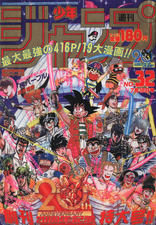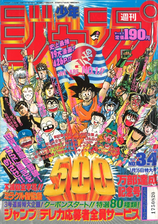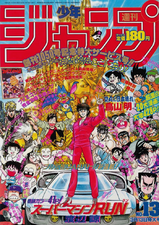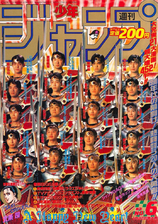Koji Koseki
Koji Koseki (こせき こうじ, Koseki Kōji) is a Japanese manga artist best-known for his baseball focused manga series, Kenritsu Umisora Koko Yakyu Buin Yamashita Taro-kun.
Koseki is a neighbor and old acquaintance of Hirohiko Araki, having been the first manga artist that Araki met in person. He is also referenced multiple times throughout the JoJo's Bizarre Adventure series, most notably earning the respect of Rohan Kishibe.
History
Koseki loved manga since he was a child and started drawing it while in high school, inspired by series such as Tetsujin 28-go. In 1978, when he was only 19-years-old, Koseki won the 16th Tezuka Award for his debut manga "Oh, Ichiro", which was then later serialized in Weekly Shonen Jump from 1980 to 1981.[1][2]
Work with Araki
Koji Koseki was the first manga artist that Araki witnessed in person. He was also present at both the Tezuka and Akatsuka award ceremonies which Araki attended.
In a postscript for the fifth volume of Koseki's manga, "Yamashita Taro-kun", Araki wrote that Koseki's works are what influenced JoJo the most out of any manga, and that Koseki is the manga artist that he holds the most respect for. He also wrote "I was taught that the heroes in manga should grow up with a purpose and have a passion more than anyone else in their hearts", in reference to the series's main protagonist.
Works
- "Oh, Ichiro" (ああ一郎) (1980-1981)
- "Scrum" (スクラム) (1982)
- "Kenritsu Umisora Koko Yakyu Buin Yamashita Taro-kun" (県立海空高校野球部員山下たろーくん) (1986-1990)
- "Pennant Race: Yamada Taichi no Kiseki" (ペナントレース やまだたいちの奇蹟) (1991-1994)
- "Boku wo Yakyu ni Tsuretette!" (ぼくを野球に連れてって!) (1996-1997)
- "Gakkari Sukenosuke" (ぽっかり助之介) (2000-2001)
- "Kabushikigaisha Oyamada Shuppan Kari Henshu Buin Yamashita Taro-kun" (株式会社大山田出版仮編集部員山下たろーくん) (2001-2004)
- "Yamashita Taro-ku: Umi to Sora no Monogatari" (山下たろーくん うみとそらの物語) (2004-2006)
- "Jitsu wa Hanashi Daifugo Tsuma Gokuhin Otto" (じつわ話大富豪妻極貧夫) (2008)
- "Over Jiman no Bakudan Nabe" (オバー自慢の爆弾鍋) (2007-2008)
- "Kamisama ga Kureta Koi" (神さまがくれた恋) (2009)
- "Tsukiyo no Suzume ~Yakitori-kun~" (月夜の雀〜やきとりくん〜) (2010-2011)
- "Sekai ni Dai Jiman Shitai Nihon no Kaisha" (世界に大自慢したい日本の会社) (2010-2015)
- "Manga de Yomu Nippon de Ichiban Taisetsu ni Shitai Kaisha" (マンガで読む日本でいちばん大切にしたい会社) (2012-2015)
Interviews
| # | Interview | Type | Media | Published |
|---|---|---|---|---|
| 1 | Kenritsu Umisora Koko Yakyu Buin Yamashita Taro-kun Vol. 5 (August 1988) | Commentary |
Manga Volume |
August 10, 1988 |
Commentary
"It's thrilling!!!" That is the term that best expresses everything I think about the JoJo's Bizarre Adventure series.
Not only do I love the great storyline (which a normal human would never imagine) but also the dialogs! Every word in Mr Araki's stories has the ability to penetrate the brain and shake it to its core. No one can imitate his sensitivity! It goes far beyond common sense! Perhaps this is one of the supernatural powers of the author!
I find myself turning each page, my heart palpitating as I wait for the words that will jump out at me, the new onomatopoeia that will be born... I can imagine Mr Araki rubbing his chin, a mischievous smile on his face, while he thinks about these dialogs and sound effects.
Finally, I'll quote one of my favorite scenes, apart from JoJo, from Baoh the Visitor. In volume 1 page 67, in the fifth box, when the bird says "Thank you!" with its short tongue.
I don't know anyone else who is able to give so much impact to such a small box and to the insignificant word of a bird.
Dear Mr Araki, although we are neighbors, we don't see each other very much. Never mind: the next time we see each other, let's have a good laugh! (like kids...)



















